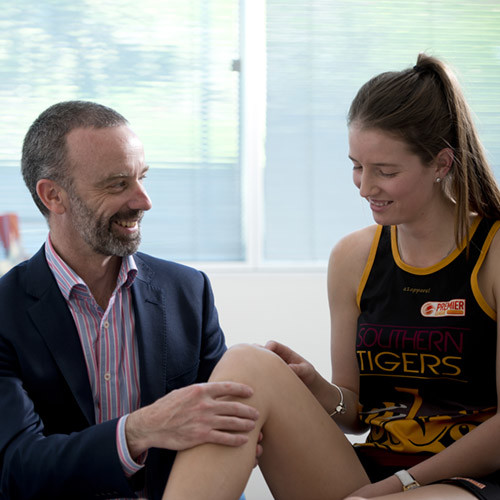Anterior Cruciate Ligament (ACL) Reconstruction
The anterior cruciate ligament is the most commonly disrupted ligament in the knee.
Our understanding of the anterior cruciate ligament and its importance to knee stability has increased greatly over the past 20 years, as has our ability to diagnose and treat this injury.

Reconstruction of the anterior cruciate ligament is a complex procedure and there are many different ways to reconstruct it.
The preferred method, at this time, is to use a portion of tendon from elsewhere as a graft. In most cases this means using the middle third of the patellar tendon or the hamstring tendons. Artificial ligaments are currently available but have not stood the test of time.
The technique for reconstructing the anterior cruciate ligament has improved in the last ten years and can now be done in an “arthroscopically aided” manner. This does not mean that there are no incisions however, because the graft has to be taken in a standard ‘open’ operation. The knee joint itself, however, is usually not opened as all the work in the knee can be done via the arthroscope. This allows for less pain, a shorter hospital stay, and an earlier and better range of knee motion. Most importantly this means less wasting of the quadriceps and hamstring muscles post-operatively and an earlier return to normal knee function.
As with any surgical procedure complications can occur.
Infection
There is a risk of infection (about1%) and this may require treatment with antibiotics or even further surgery.
Ongoing Instability
There is a risk of ongoing instability in the knee, even with surgery (5-10%) post operation.
Stiffness
There is a risk of stiffness in the knee and occasionally a further arthroscopy is required to address scar tissue in the knee joint.
Numbness
You may experience numbness adjacent to the scar for some months after surgery and also feel some discomfort when kneeling for up to twelve months.
Hospital Admission
Following admission to hospital you will be seen by the anaesthetist. The operation usually requires a general anaesthetic.
When you awake following the operation you will have some discomfort in your knee and you will be given appropriate pain relief for this. You will have an intravenous line in one arm and sometimes a drain from the site of the operation, which will be removed the next day. You will be attended by the physiotherapist who will teach you exercises and when you are comfortable you will get up and about. A splint is usually required. The physiotherapist may place your knee in a Continuous Passive Motion Machine (CPM) if you are having trouble bending it.
Length of stay
Reconstruction of the anterior cruciate ligament is now an everyday procedure thanks to the very major advances in techniques that have occurred over the last decade. Therefore only a short stay of one or two nights in hospital is required.
Prior to going home you will be given a sheet of instructions and exercises, which you must do, regularly at home. Arrangements will be made for you to see a physiotherapist after your postoperative appointment, which is approximately two weeks after discharge from hospital.
You will also be given pain-relieving tablets to use at home as necessary.
Your surgeon will discuss this with you, but may include a period using a brace, crutches or both.
It is normal to experience some pain after surgery and this is usually very well controlled with paracetamol, anti-inflammatories and Ice. Sometimes stronger pain relief may be needed for a few days.
It is important to commence you rehabilitation exercises immediately after surgery and your surgeon will let you know when to start these and when to see your physio.
Return to sport varies from person to person, but will usually not be before 9 months after your surgery and may be longer.
Book an appointment with our orthopaedic specialists
Book an appointment